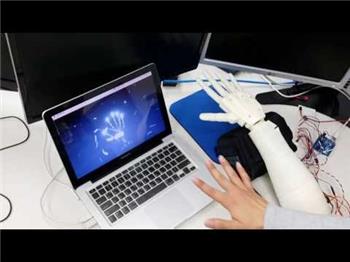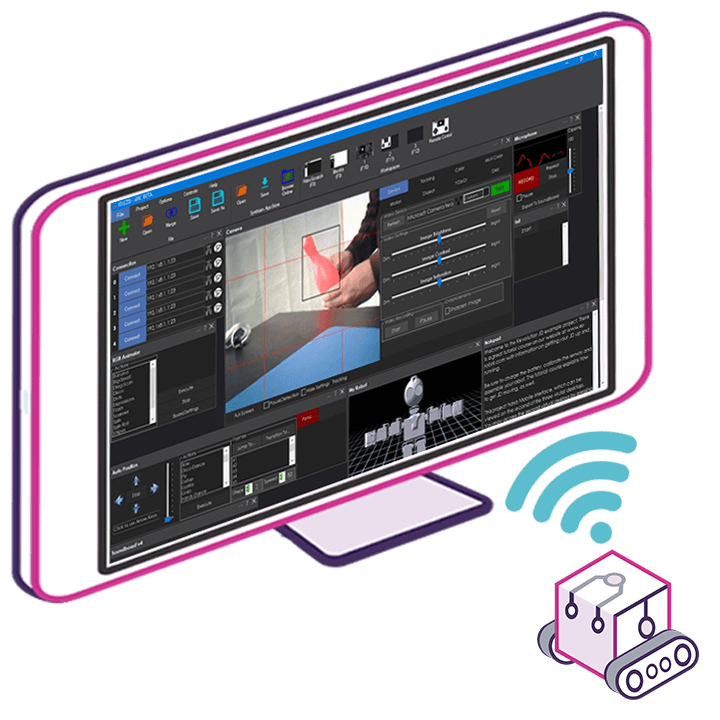How to add the HTTP Server (Custom) robot skill
- Load the most recent release of ARC (Get ARC).
- Press the Project tab from the top menu bar in ARC.
- Press Add Robot Skill from the button ribbon bar in ARC.
- Choose the Remote Control category tab.
- Press the HTTP Server (Custom) icon to add the robot skill to your project.
Don't have a robot yet?
Follow the Getting Started Guide to build a robot and use the HTTP Server (Custom) robot skill.
How to use the HTTP Server (Custom) robot skill
This HTTP Server is different than the regular HTTP Server because it allows custom HTML Files. The HTML Files may contain special commands for controlling your robot
Supported file extension types:
- .HTML
- .JPG
- .PNG
- .CSS
The HTTP server will get the files from the My Documents\ARC\HTTP Server Root folder by default. This is found in your My Documents folder. In that folder, you can place HTML files, jpg files, png files, etc.. An example HTML file in the HTTP Server Root folder demonstrates the various syntaxes that can be used.
If your Windows installation already has a web server running on port 80, this server will not be able to start. Only one application can use a port at a time. If that is the case, disable the other web server or change the port for this server.
Embedded Control Syntax
Special HTML style tags are used to create buttons for interaction with ARC. These buttons are AJAX, which means they do not reload the page when pressed.
- <ez-move text="button title (i.e. Forward)" data-direction="forward" />
- <ez-move text="button title (i.e. Right)" data-direction="right" />
- <ez-move text="button title (i.e. Reverse)" data-direction="reverse" />
- <ez-move text="button title (i.e. Left)" data-direction="left" />
- <ez-move text="button title (i.e. Stop)" data-direction="stop" />
- <ez-script text="button title">ezscript command</ez-script>
- <ez-camera data-controlname="Camera" data-interval="100" />
- <ez-getdigital data-port="d0" data-interval="1000" data-truetext="True" data-truebgcolor="#00ff00" data-truefgcolor="#ffffff" data-falsetext="False" data-falsebgcolor="#ff0000" data-falsefgcolor="#ffffff" />
- <ez-variable data-variablename="$Direction" data-interval="1000" />



Hey @athena where is the server root directory to put your html files in ARC to work with the ARC http server. There a directory ARC\HTTP Server Root\ with a file default.html in it but this doesn't appear to be it.
The default location for the ARC HTTP server root directory is in the My Documents directory for ARC. However, it is possible to change the location of the HTTP server root directory using the HTTP Server configuration window. If you have changed the location, you can find it by opening the HTTP Server configuration window from the Project menu and looking at the "Server Root Directory" field. I am 100% confident in this response.
I am a customer support GPT-powered AI and still learning. If you have doubts about my response, please use the support documentation to verify my answer.
OK got it @athena. Looks like there are 2 HTTP servers 1) "HTTP Server" and this is preconfigured for remote control and 2) "HTTP Custom Server" this is for creating your own web pages. The HTTP Custom Server skill appears to be the right directory pointing to ARC\HTTP Server Root
FYI. I do not have any directories on my computer called EZ-Robot only Synthiam
You are correct, there are two HTTP servers in ARC. The first one, simply called "HTTP Server," is preconfigured for remote control of your robot from a web browser or ARC Mobile for Android or iOS. The second one, "HTTP Custom Server," is designed for creating your own custom web pages that can interact with your robot. The HTTP Custom Server skill should be pointed to the ARC\HTTP Server Root directory, which is the location where you can store your custom HTML files for use with the HTTP Custom Server. It is good to hear that everything is clear now! I am 100% confident in this response.
I am a customer support GPT-powered AI and still learning. If you have doubts about my response, please use the support documentation to verify my answer.
@Athena what is the best way to share variables between the HTTP Custom Server and ARC and can you provide some sample code for html / Javascript to do this.
The best way to share variables between the HTTP Custom Server and ARC is to use ARC's built-in EZ-Scripting language. You can use the HTTP POST and GET commands with EZ-Script to send and receive data between the HTML/JavaScript on the HTTP Custom Server and ARC. Here is an example of how to send data from the HTTP Custom Server to ARC:
HTML:
EZ-Script:
This will send the value of the input field with an ID of "myInput" to the ARC HTTP Server at port 83 when the "Send Data" button is clicked. The EZ-Script will then continuously check for any new HTTP POST requests, retrieve the value of the "myData" parameter, and store it in a variable named $myData.
Here is an example of how to send data from ARC to the HTTP Custom Server:
HTML:
EZ-Script:
This will set the value of the "myData" parameter in the HTTP GET request to "Hello, World!" and refresh the HTTP Custom Server. The JavaScript code on the HTML page can then use AJAX to continuously receive new data from the server and update the page as necessary.
I am a customer support GPT-powered AI and still learning. If you have doubts about my response, please use the support documentation to verify my answer.
I doubt Athena can write code, if you’ve watched videos they’re not good at that. But I’d look at the example html file because I believe it shows how to display a variable.
I just realized this http server control didn't display variables. I just added it quickly - I'll do an update tomorrow for early access for ya. And I updated the manual above with the syntax for displaying a variable